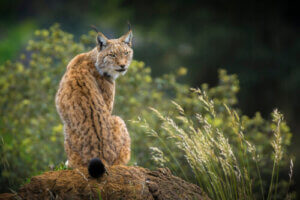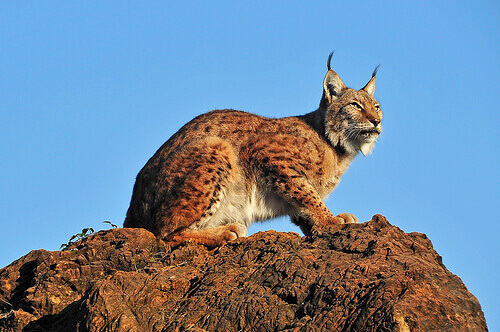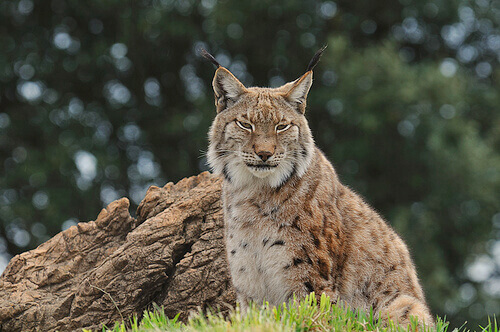The Lynx from the Iberian Peninsula: Highly Endangered

The lynx from the Iberian Peninsula has been on the verge of extinction in recent decades. We’re going to introduce to you this unique feline and tell you the story of its recovery.
Characteristics of the Iberian lynx
The Iberian lynx is a medium-sized feline, although small in comparison to other lynx species. Adult males are slightly larger than females: females weigh about 10 kilograms (22 lb) and males can reach 13 kilograms (28 lb).
They have a short tail, ending in a black tuft, which they always hold raised. They’re brown or gray with black and white spots. These spots can have different sizes and color intensities.
However, the most typical physical trait of this lynx species are the tufts on the tips of its ears. These help it camouflage, and consist of thick black hair. Two white sideburns hang under the cheeks, and they get bigger with age.
Proportionally, they’re graceful looking animals with long legs. They’re intelligent and live in groups. They’re great hunters, even if they act alone, and don’t develop collective strategies like other specimens.
Diet
The Iberian lynx is a carnivorous animal, with 90% of its diet consisting of hares. However, this proportion can change depending on the season.

During summer, it feeds almost entirely on hares, but in winter, when there’s a drop in the population of lagomorphs, it looks for other prey. Its diet also includes other small mammals or birds, but reportedly it also hunts young goats or fawns.
One of the problems regarding the conservation and recovery of the Iberian Lynx is its diet. This lynx species is so selective with its prey that it requires a habitat where this is abundant. Moreover, the diseases of its prey are also a cause for alarm in the context of its survival.
Habitat
The Iberian lynx lives in the Mediterranean forests – places that aren’t very steep, with large stretches of flat land, many bushes, and low grass. There are few places like this in the Iberian Peninsula, which haven’t been affected by human activity.
A few decades ago, the lynx lived in Andalusia, Sierra Morena and Sierra de Gata in Spain, and in the south of Portugal. During the first years of the 21st century, it disappeared in many of these places. Nowadays, it survives mainly in Andalusia, concentrated in the Doñana Natural Park and has been reintroduced to the Sierra Morena.
However, other habitats are prepared for its introduction, thus hoping to achieve the expansion of the species, for example, the Guadiana valley in Portugal. Its introduction is also planned for places with stable populations of hares and ceased human activity.
Recovery in progress
During the first years of the 21st century, the lynx was so scarce that the species was in critical danger of extinction. It was estimated that less than 100 specimens remained. Fortunately, conservation efforts are paying off, and there are now more than 500 specimens.

There are several projects underway aiming to achieve its recovery. Its way of life is being studied in depth in order to prepare new habitats. Moreover, there are captive breeding projects ensuring its reproduction.
Additionally, their reintroduction was successful in places where they had disappeared. This step has been a success, as they’re being born in the wild without human intervention. In some areas, there are many hidden cameras aiming to discover exactly how they live and what problems they face.
Threats to the lynx from the Iberian Peninsula
Even if data is optimistic, we mustn’t forget that the lynx is still in danger of extinction in the Iberian Peninsula. 2017 and 2018 were years in which there were many births. However, there were also many accidental deaths that could have been prevented.
Currently, the greatest fatal danger for the Iberian lynx are road kills, as there are secondary roads crossing part of its habitat. Moreover, traps set for other animals, such as foxes or rabbits, are of concern because lynxes are also threatened by their existence.
The Iberian lynx is the most threatened feline in the world, however, it’s in the process of recovery. It’s a careful and slow work, but data from the last decade appears to be optimistic.
The lynx from the Iberian Peninsula has been on the verge of extinction in recent decades. We’re going to introduce to you this unique feline and tell you the story of its recovery.
Characteristics of the Iberian lynx
The Iberian lynx is a medium-sized feline, although small in comparison to other lynx species. Adult males are slightly larger than females: females weigh about 10 kilograms (22 lb) and males can reach 13 kilograms (28 lb).
They have a short tail, ending in a black tuft, which they always hold raised. They’re brown or gray with black and white spots. These spots can have different sizes and color intensities.
However, the most typical physical trait of this lynx species are the tufts on the tips of its ears. These help it camouflage, and consist of thick black hair. Two white sideburns hang under the cheeks, and they get bigger with age.
Proportionally, they’re graceful looking animals with long legs. They’re intelligent and live in groups. They’re great hunters, even if they act alone, and don’t develop collective strategies like other specimens.
Diet
The Iberian lynx is a carnivorous animal, with 90% of its diet consisting of hares. However, this proportion can change depending on the season.

During summer, it feeds almost entirely on hares, but in winter, when there’s a drop in the population of lagomorphs, it looks for other prey. Its diet also includes other small mammals or birds, but reportedly it also hunts young goats or fawns.
One of the problems regarding the conservation and recovery of the Iberian Lynx is its diet. This lynx species is so selective with its prey that it requires a habitat where this is abundant. Moreover, the diseases of its prey are also a cause for alarm in the context of its survival.
Habitat
The Iberian lynx lives in the Mediterranean forests – places that aren’t very steep, with large stretches of flat land, many bushes, and low grass. There are few places like this in the Iberian Peninsula, which haven’t been affected by human activity.
A few decades ago, the lynx lived in Andalusia, Sierra Morena and Sierra de Gata in Spain, and in the south of Portugal. During the first years of the 21st century, it disappeared in many of these places. Nowadays, it survives mainly in Andalusia, concentrated in the Doñana Natural Park and has been reintroduced to the Sierra Morena.
However, other habitats are prepared for its introduction, thus hoping to achieve the expansion of the species, for example, the Guadiana valley in Portugal. Its introduction is also planned for places with stable populations of hares and ceased human activity.
Recovery in progress
During the first years of the 21st century, the lynx was so scarce that the species was in critical danger of extinction. It was estimated that less than 100 specimens remained. Fortunately, conservation efforts are paying off, and there are now more than 500 specimens.

There are several projects underway aiming to achieve its recovery. Its way of life is being studied in depth in order to prepare new habitats. Moreover, there are captive breeding projects ensuring its reproduction.
Additionally, their reintroduction was successful in places where they had disappeared. This step has been a success, as they’re being born in the wild without human intervention. In some areas, there are many hidden cameras aiming to discover exactly how they live and what problems they face.
Threats to the lynx from the Iberian Peninsula
Even if data is optimistic, we mustn’t forget that the lynx is still in danger of extinction in the Iberian Peninsula. 2017 and 2018 were years in which there were many births. However, there were also many accidental deaths that could have been prevented.
Currently, the greatest fatal danger for the Iberian lynx are road kills, as there are secondary roads crossing part of its habitat. Moreover, traps set for other animals, such as foxes or rabbits, are of concern because lynxes are also threatened by their existence.
The Iberian lynx is the most threatened feline in the world, however, it’s in the process of recovery. It’s a careful and slow work, but data from the last decade appears to be optimistic.
This text is provided for informational purposes only and does not replace consultation with a professional. If in doubt, consult your specialist.








